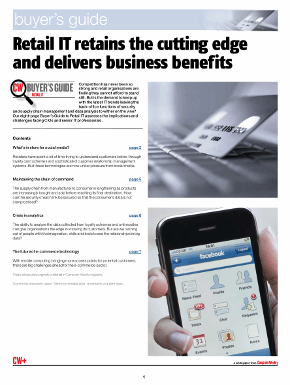CIO interview: Pete Marsden, CIO, Asos.com
As online fashion retailer Asos.com continues to expand, its IT strategy is focused on new international locations and keeping up with web retail
As online fashion retailer Asos.com continues to expand, its IT strategy has focused on supporting new international locations and keeping up with the demands of web retail.
Despite the slowdown in consumer spending in the UK, the company still saw growth as third-quarter sales up 45% to £194m. UK sales rose 39% but the international business performed even better, with growth of 48%.
Asos already has dedicated websites and local teams in the US, France, Germany, Australia and Russia. Expansion will continue in 2013 with the launch of the China business, a key area of focus for the IT team – as is supporting the technology underpinning a fast-growing and changing organisation.
But Asos's success doesn’t mean there is room for complacency, says CIO Pete Marsden.
“No organisation can rest on its laurels - we have incredible competition from online and high street retailers. Sure, we do have some advantages and a great scalable business but you never underestimate the high street competition,” Marsden told Computer Weekly.
“High street retailers can offer customers the feel and touch of products and that is a huge advantage, which is why people love going shopping. So that’s why we need to think of ways in which we can make Asos an exciting place to shop, just as much as in the high street.”
Resolving complexity
As a pure-play online business, Asos originally had the luxury of building its IT from scratch – but that does not mean it avoids some of the legacy technology headaches that longer-established firms face.
“When you are a small organisation it is very easy to cope with a rapid pace of change, but the bigger you get, the more complex the IT set-up gets and the slower you become,” says Marsden.
“But Asos’s website is incredibly feature-rich and, when looking at some of the alternatives in the market, we found that the existing improvements we made over the years made it a quite industry-leading website already, so replacing what we had with a package would be taking us backwards in some cases, so it was not appropriate for us.
“So my job is to try and keep up with the small and entrepreneurial feel of the organisation and make sure it has an architecture that supports the new requirements that frequently arise.”
Large organisations tend to have that distance that builds up between technology and business teams they support and that is a real mistake – so it is very important that I do everything I can do to try and stop that from happening
Pete Marsden, Asos.com
Most of the Asos website is built in-house and based on Microsoft .net technologies. Marsden’s team has just rolled out Sitecore, the content management system underpinning the website, and is also working on improving the checkout and shopping basket functionality.
“But we are also hoping to really improve engagement in the next two to three months. And we have more than 60,000 product lines, so it is important to enhance our search capability over time too,” Marsden says.
Asos works with retail software specialists for some of its core systems. Most of its warehouse management, stock control and distribution systems are based on the software as a service (SaaS) model. The company uses Red Prairie, Merret and Metapack platforms for each of those areas respectively.
“We are always looking at alternatives in the market, but we have decided to upgrade two systems and trust they will be supporting us sufficiently for the future,” says Marsden.
Other examples where SaaS can be found at Asos include the Maple Leaf forecasting tools used by the buying team, as well as Office 365, used by all of the company’s staff worldwide.
“We are so small and the vast majority of our staff are based in one building, so we are quite embryonic in terms of corporate technology, despite having some clever tools to help people manage parts of the business,” Marsden says.
A move to a new datacentre is on the cards. Marsden says the company is in talks with partner Xerox about the project.
Introducing a bring your own device (BYOD) policy is also a possibility, but Marsden is approaching that trend one step at a time.
“It is early days and we don’t have the same demands as some organisations, such as the BBC, who have a large number of contract and transient workers,” he says.
“However, just from a cost saving and ease of use perspective we’ve started linking some of our people’s personal iPads. We’re confident we have the right security profiles and processes in place to make this work for the individual and for Asos.”
Making sense of big data
According to Marsden, Asos generates and processes huge amounts of data for a company of its size. It is getting to the point where it will start measuring data volumes in petabytes. The internal IT team is using big data tools such as Hadoop to handle that information and extract the analysis Asos needs, such as what products are selling well and what customers are looking for.
“The information we have is incredible. We are using Hadoop mainly because of the speed with which it can generate the information we need and the cost reductions it generates,” Marsden says.
“My main job is to ensure we have the data in the right quality and format, so the business teams can manipulate the information. We are using data to drive internal change and our behaviour on our customers’ behalf,” he says.
Read more interviews with retail CIOs
- Dan West, group IT director, New Look
- Paul Clarke, director of technology, Ocado
- Tesco CIO Mike McNamara on the retailer's digital future
- Steve Monaghan, IT & e-commerce director, Waterstones
- Darrell Stein, IT director, Marks & Spencer
- Colin Rees, IT director, Domino's Pizza
- Paul Coby, CIO of John Lewis
“If we can understand what is trending with customers, we can make sure we get the right products into the warehouse and maximise that trend. Conversely, it is important to know which products are not trending and why.”
However, the CIO makes the point that getting to the stage where data can deliver that sort of insight is not a simple task.
“You have to get the basics in place. A lot of organisations have huge amounts of data, but also a lot of inconsistencies in the information itself. So understanding what the true data sources are, tidying it up, consolidating data warehouses and so on can be very difficult,” Marsden says.
“It can also be expensive. Some organisations, like Royal Bank of Scotland, have been around for several decades and have systems that are as old as they are, so cleaning up data can be costly and time-consuming.”
The Chinese operation
Unlike its main website, Asos decided to use an off-the-shelf e-commerce engine provided by Hybris to launch its Chinese operation. Marsden’s team selected Netsuite as its enterprise resource planning (ERP) system and Mulesoft as the integration platform.
ChinaNetCloud is leading service delivery for the infrastructure and existing partner Cognizant will support Asos's testing and recruitment.
“We have already hired a great IT director in China and want to make sure we have a very strong Chinese management team,” says Marsden, pointing out that he has had no issues at all in recruiting good IT professionals in China.
“We have found people in China to be amazing and very passionate about what they do – it’s just a case of finding the best. They can really teach us a lot,” he adds.
“What we are doing in China is to leverage on the expertise of our partners – Cognizant, for example, has some really good contacts there and they are helping us hire the best people with the best knowledge.”
Computer Weekly Buyer's Guide to Retail IT

Is the demand to keep up with the latest IT trends leaving the back-office functions of security and supply chain management and data analysis to wither on the vine? Our eight-page Buyer’s Guide to Retail IT assesses the implications and challenges facing CIOs and senior IT professionals.
Chinese customers are “incredibly demanding” about what they are looking for in websites, says Marsden. Asos has added three times more images of products than it provides on the UK website to accommodate demand. The CIO also points out that these findings will be useful in improving the websites of all countries.
Retaining talent
Marsden leads a team of 280 in-house staff, plus about 100 Cognizant contractors in China and India. He joined Asos in September 2012 – before that, he held top IT management roles at very different companies including Royal Bank of Scotland, Egg and Orange.
“Retail has a pace of change and demands far higher than in other sectors. However, the benefit here is that the organisation is so much more tightly knit, people work much more closely,” he says.
“Unfortunately, large organisations tend to have that distance that builds up between technology and business teams they support and that is a real mistake – so it is very important that I do everything I can do to try and stop that from happening.”
One of Marsden’s major goals this year – besides preparing for the China launch and winding down any new releases from October ahead of Christmas – is retaining IT talent in the UK.
“The difficulty is to create a great team and culture inside an organisation. We have some truly brilliant people - my job is to keep giving people opportunities to do great things,” he says.
“We are a much smaller employer than Google, who just opened an office down the road from us. If you are a great technologist, you need to make a choice, do you want to work somewhere like Google or Asos? I can’t compete financially with the likes of Google, but I certainly will do whatever I can to make this a great place to work.”











